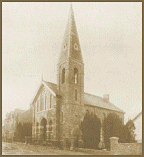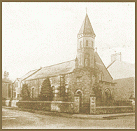 The
Baptists had a chapel in Market Street
for many years rebuilding it twice in the 19th century to make room for
more congregation.
The
Baptists had a chapel in Market Street
for many years rebuilding it twice in the 19th century to make room for
more congregation.
In 1899 they built a fine new chapel with a spire in West Street (see
left). Many of the visitors to the town came from South Wales where
there were thousands of Nonconformist chapels  and
the many chapels in Builth opened their doors to the visitors.
and
the many chapels in Builth opened their doors to the visitors.
The Horeb
Congregational Chapel (right) was built in 1869 by a
Manchester architect for £1800. It was built on the site of an earlier
chapel and it too had a spire which was visible from a long way off making
Horeb Chapel something of a local landmark.
 The
Methodists in the town who followed the teachings of John Wesley first built
a chapel on the corner of the Hay Road and Castle Road. With the growth
of Builth Wells and the increase in visitors, the Wesleyan
Methodists also decided they needed a new, larger chapel. In
1895 they opened a new chapel in Garth Road.
The
Methodists in the town who followed the teachings of John Wesley first built
a chapel on the corner of the Hay Road and Castle Road. With the growth
of Builth Wells and the increase in visitors, the Wesleyan
Methodists also decided they needed a new, larger chapel. In
1895 they opened a new chapel in Garth Road.